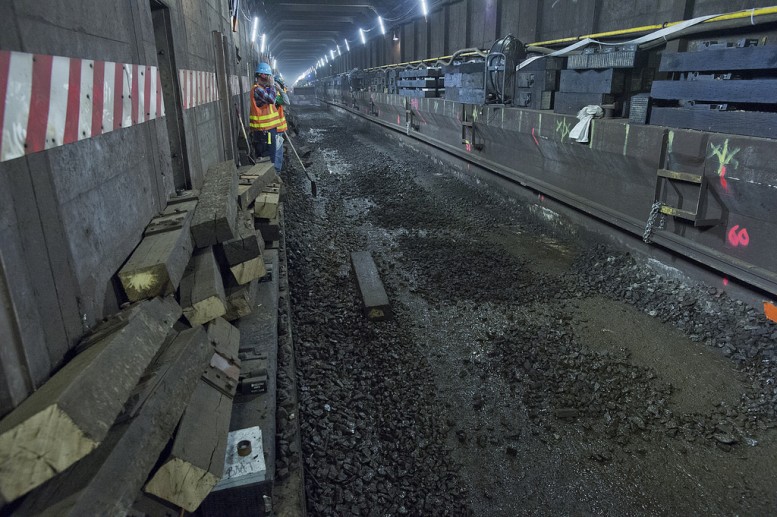The Citizens Budget Commission released a report earlier this week that predicted the MTA wouldn’t be able to fully repair all 467 of its subway stations until 2067, with suggestions on how the transit authority could finance repairs faster. The watchdog group outlined three ways the agency could find the money to bring all the stations into a state of good repair in 20 to 30 years, rather than 50:
- Divert money from major expansion projects—namely the Second Avenue Subway and East Side Access—to repair work. They point out that if the $1.5 billion earmarked for the next phase of Second Avenue were shifted toward maintenance, the MTA could pay for 85% of its repairs in the next 30 years. An extra $360 million a year would go toward fixing platforms, stairs, and ventilators. But let’s face it, the MTA isn’t going to abandon the Second Avenue Subway unless the city gets hit with another major financial crisis.
- Implement better project management. The median delay for station rehab projects was about 11 months, and those fixes ended up costing the MTA $324 million more than originally planned.
- Create more public-private partnerships. The most recent example is One Vanderbilt, where SL Green agreed to fund $210 million in subway upgrades for Grand Central in exchange for a huge upzoning.
Public-private partnerships, or P3s, can be incredibly effective when negotiated and executed correctly. But they also have a thorny history in the U.S. and western Europe. In 2008, Chicago made $1.5 billion by leasing 36,000 parking meters to a private consortium for 75 years. Now every time the city closes a street, it has to compensate the private contractor for lost revenue.
To complicate matters further, politicians often sell P3s to the public as money with no strings attached, simply because the funding doesn’t come directly out of city or state coffers.
“One of the most widely held misconceptions about public-private partnerships is that the private sector somehow provides funding—or free money— for infrastructure projects,” the Eno Center for Transportation, a D.C. think tank, wrote in its 2014 report on P3s. “In fact, private partners do not provide funding. They can, however help to assemble financing packages that may include public and private loans or public bonds, but, like any debt, this requires repayment.”
Two years ago, state Comptroller Thomas DiNapoli wrote that, “Private financing could be viewed as a new form of backdoor borrowing…It is important to recognize that private financing does not constitute a new source of funding – ultimately, the costs will be borne by the public.”
And New York State doesn’t have any formal legislation governing P3s, meaning that there’s limited oversight of the process, its results or how much it’s costing the public. The lack of a formal policy puts the state—and by extension, New York City—at a disadvantage when it comes to negotiating with private contractors, according to DiNapoli.
Until now, P3s have mostly been used to build highways and bridges, like the new Tappan Zee Bridge under construction 20 miles north of the city. However, Denver is becoming one of the first cities to build a major public transit project through a public-private partnership. The undertaking, the Eagle P3 Project, will bring 36 miles of commuter rail track to Denver and link the city’s downtown with its airport.
Denver’s Regional Transport District, a public agency, owns all the revenues, advertising and naming rights, and the private contractor takes on the cost of operation, maintenance and repairs, according to NextCity.
Construction on Eagle P3 is set to finish in 2016. If it turn out to be successful, it may serve as a model for P3s in cities like New York. And going forward, P3s could help alleviate the $14.8 billion shortfall in the MTA’s capital budget.
Subscribe to YIMBY’s daily e-mail
Follow YIMBYgram for real-time photo updates
Like YIMBY on Facebook
Follow YIMBY’s Twitter for the latest in YIMBYnews


In cases where a subway station sits within an area serviced by a BID, routine repair and maintenance, including, but not limited to, cleaning, removing graffiti and replacing broken tiles, should be transferred to the BID, which, in turn, should be able to increase its assessment to local area businesses to cover the cost of its increased functions.
The new Tappan Zee Bridge is NOT a P3. It is a publicly financed design-build project.